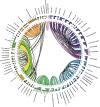Systematic Detection of Large-Scale Multigene Horizontal Transfer in Prokaryotes
- PMID: 33565580
- PMCID: PMC8136488
- DOI: 10.1093/molbev/msab043
Systematic Detection of Large-Scale Multigene Horizontal Transfer in Prokaryotes
Abstract
Horizontal gene transfer (HGT) is central to prokaryotic evolution. However, little is known about the "scale" of individual HGT events. In this work, we introduce the first computational framework to help answer the following fundamental question: How often does more than one gene get horizontally transferred in a single HGT event? Our method, called HoMer, uses phylogenetic reconciliation to infer single-gene HGT events across a given set of species/strains, employs several techniques to account for inference error and uncertainty, combines that information with gene order information from extant genomes, and uses statistical analysis to identify candidate horizontal multigene transfers (HMGTs) in both extant and ancestral species/strains. HoMer is highly scalable and can be easily used to infer HMGTs across hundreds of genomes. We apply HoMer to a genome-scale data set of over 22,000 gene families from 103 Aeromonas genomes and identify a large number of plausible HMGTs of various scales at both small and large phylogenetic distances. Analysis of these HMGTs reveals interesting relationships between gene function, phylogenetic distance, and frequency of multigene transfer. Among other insights, we find that 1) the observed relative frequency of HMGT increases as divergence between genomes increases, 2) HMGTs often have conserved gene functions, and 3) rare genes are frequently acquired through HMGT. We also analyze in detail HMGTs involving the zonula occludens toxin and type III secretion systems. By enabling the systematic inference of HMGTs on a large scale, HoMer will facilitate a more accurate and more complete understanding of HGT and microbial evolution.
Keywords: Aeromonas; genome evolution; horizontal gene transfer; phylogenetics; prokaryotes.
© The Author(s) 2021. Published by Oxford University Press on behalf of the Society for Molecular Biology and Evolution.
Figures






References
-
- Bansal MS, Banay G, Harlow TJ, Gogarten JP, Shamir R.. 2013. Systematic inference of highways of horizontal gene transfer in prokaryotes. Bioinformatics 29(5):571–579. - PubMed
Publication types
MeSH terms
LinkOut - more resources
Full Text Sources
Other Literature Sources

